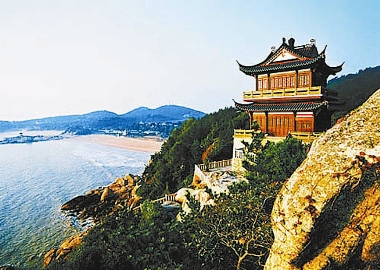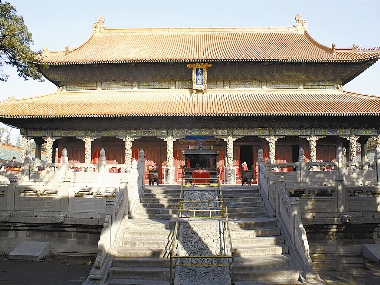



THE purposes of traditional Chinese medicine include fitness enhancement, disease prevention, and postponement of aging. But medicine is not the only way to do these things. Resting in a quiet valley or a peaceful temple is also a kind of medicine. Here is a list of destinations in China that are regarded as being conducive to good health.
Yangshuo County Yangshuo, a small county in southern China’s Guangxi Zhuang Autonomous Region, is a good place to relax the mind and body with its mountains, tea tree forests and traditional culture. An area of breathtaking beauty, Yangshuo has over 1,400 years of history that locals are fiercely proud of. The county’s ethnic minority groups include Hui, Zhuang and Yao. The groups all have their own customs, and the exoticism is increased by the abundance of foreign visitors. The famouly clean Lijiang River traverses the county’s beautiful scenery. This scenery includes hundreds of hills, including Moon Hill, Mural Hill and Schoolboy Hill, which is the setting of the world-famous play “Impression Liu Sanjie.” Big banyan, a huge tree with a history of over 1,400 years, is said to be the place where the love story that inspired the performance happened. The Yulong River is a paradise for a cruise because of its green hills, silky water and ancient bridges. Transport: Fly to Guilin in the Guangxi Zhuang Autonomous Region from Shenzhen Bao’an International Airport, then take a bus to Yangshuo County. Accommodation: Stay at the hostels there, or stay with locals to experience their lifestyle and food. Cuisine: Try beer fish, Niang dishes and special snacks, including rice noodles and various glutinous rice cakes. Putuo Mountain Putuo Mountain is located in Zhejiang Province. It is famous in Chinese Buddhism and is considered the bodhimanda of Guanyin, a revered Bodhisattva in many parts of East Asia. The mountain is one of the four sacred mountains in Chinese Buddhism. It lies on the Eastern Sea of China and displays the beauty between sea and mountain. The area is about 12.5 square kilometers and has lots of famous and sacred temples. According to Buddhist legend, Bodhisattva Guanyin expounded Buddhist doctrine there 1,000 years ago. Every year on Feb. 19, June 19, Sept. 19 on the Chinese lunar calendar, Putuo Mountain welcomes millions of people for the celebration of the birth of Guanyin, being a monk and being bodhisattva. Major temples on Putuo Mountain include Puji, Fayu and Huiji temples, which are the largest among more than 20 extant temples in China. Puji Temple, covering an area of about 11,000 square meters, was built during the Tang Dynasty (618-907), and is the main temple enshrining Guanyin on the mountain. The temple has a nine-meter-high Guanyin statue and 32 smaller Guanyin statues. Transport: Fly to Shanghai or Hangzhou from Shenzhen Bao’an International Airport, then take a bus to Putuo Mountain. Accommodation: Stay at the hostels on Putuo Mountain, or stay at the temples. Cuisine: Try Buddhism tea and dishes at the temples on the mountain. Qufu City Qufu City, situated in Shandong Province, is the hometown of Confucius and offers an abundance of palaces, temples and cemeteries. It was on the first list of 24 famous historical and cultural cities announced by the State Council. Qufu served as the capital of the State of Lu during the Spring and Autumn Period (770-476 B.C.). The three most famous cultural sites in Qufu are the Temple of Confucius, the Cemetery of Confucius and the Kong Family Mansion, which have been UNESCO World Heritage Sites since 1994. A must-go is the Temple of Confucius, a group of grand buildings built in Oriental style. It covers an area of 16,000 square meters and has a total of 460 rooms. Along with the Summer Palace in Beijing and the Mountain Resort of Chengde, the Temple of Confucius is one of the three largest ancient architectural complexes in China. At the temple, which is surrounded by stately halls, elegant pavilions, a dignified memorial archway and classical courtyard, tourists will gain an insight into the life and times of the Chinese philosopher and his role in history. Transport: Fly to Jinan in Shandong Province from Shenzhen Bao’an International Airport, then take a bus to Qufu. Accommodation: There is a wide selection of hotels and hostels there, or stay at the local’s to enjoy fresh farm produce. Cuisine: Qufu rice and Kong family feast are recommended, especially duck, seafood and bean curd. (Jane Lai) | 
